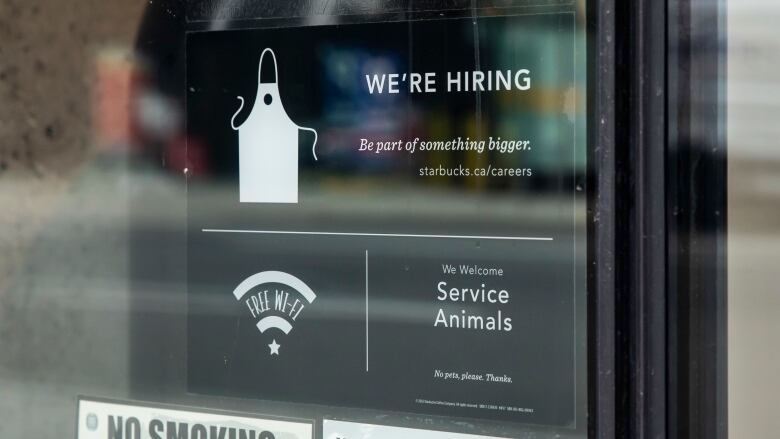Alberta job vacancy numbers levelling off, StatsCan data shows
Numbers at historic highs with no sign of decreasing further, labour researcher says

Alberta's worker shortage is showing signs of levellingoff, according to thelatest update ofquarterly numbers from Statistics Canada,from July to September 2022.But the demand for people to fill positions across the economy still remains at historic highs.
That means even asspeculation over a coming recessiongrows, large increases in unemployment may be avoidedfor many sectors where demographics and skills shortages play a role, according analysts.
"I don't think unemployment is going to rise as dramatically as perhaps the number of job vacancies decreases. Let's put it that way," said Janet Lane, director of the Canada West Foundation's Human Capital Centre.
"There is a number of baby boomers that are finally saying, 'OK, I'm done now.' Thathas gone up, anddefinitely in some sectors, that's a real issue."
Lane says Albertans can see things are looking better for workers in the ratio of job seekers to vacancies, which is approaching oneto one. Five years ago, it was closer to three to one.
Unemployment numbers for the third quarter ranged from 4.8 per cent in July to 5.5 per cent in September. Alberta's unemployment rate in November was at 5.8 per cent, according to Statistics Canada.
Third-quarter job vacancies essentially remained flat, edging downward to five per cent from 5.3 per cent in the second quarter.
However, that number varies widely depending on the industry, and Albertans can expect that to continue as the "new normal,"according to Alberta Business Council economist Alicia Planincic.
"If we were to see a recession, by definition, that would mean that we are seeing layoffs. However, I think an important consideration for the next year is there are going to be certain industries that may be impacted more than others," she said.
Planincic and Lane both say the construction, oil and gas and other industries related to skilled tradesare seeing a lot of retirements currently and will continue to have labour shortages going into the next year.
Job vacancies in accommodation and food service industriesin Alberta during the third quarter were double that of the wider economy at 10.3 per cent, also down slightly from the previous quarterbut still much higher than many in the industry would like.
"We just have this enormous challenge of trying to find people and bring them back to an industry thatthrough COVIDwas pretty much shut down," said Dave Kaiser, president of the Alberta Hotel and Lodging Association.
Kaiser said many workers in the food and hotel industry left with the repeated shutdowns, a lot finding jobs at Amazon warehouses, returning to school or finding employment elsewhere. Some have come back but only to part-time hours.
With increased inflation, employers are trying to manage their labour costs and pass along further price increases to consumers.
"They have to offer higher wages to attract people, but every industry is in a similar boat. So you raise your wages and the next industry does. You get into this wage spiral as well and you're still short people," Kaiser said.
The trouble is getting workers trained up with the right skills paired to the in-demand jobs, Lane says.
In a different Statistics Canada data set, 78 per cent of food and accommodation employers reported having a skills gap among their workforce.
"We need to work with employersand incentivize employers somehow to do more of that training on the job," Lane said."The days of give me job-ready candidates if they ever existed are definitely over at this point."
In health care, the vacancy rate is comparatively low, but worker shortages have beenaffecting services.
Vacancies here, too, have fallen from their peak earlier in the year but arehigher than at any point in the five years prior to the pandemic.
Potential for long-term damage
Construction also has a high vacancy rate. When comparing it to overall number of jobs, there is potential for another problem on the horizon, according to Lane.
There are stillfewer people employed inthe construction industry than at the end of the last oil boom in 2015. But with sevenper cent of positions currently unfilled, there is a risk ofprojects not getting built and hurting long-term growth, Lane said.
Demographic forces have particularly hurt that industry in recent years as older workers can't delay retirement in more physically demanding careers.
Lane says government and educational institutions need to do a better job of emphasizing construction and trades can be meaningful work for young people.
"There's a lack of young people who are willing to go into the trades," she said."We've taught young people that, you know, go to university, get your degree, you'll be in great shape."
Construction and restaurants are great industries for on-the-job training for newer workers and have lower barriers for entry, she said.
"The realityis that it is a fun place to workand to learn important skills that are transferable to many other occupations," Kaiser said."And for those that really love the industry, there's real opportunities to move up and to move up quickly, because we're, you know, we've got all these openings."
Moving into 2023, as the Bank of Canada moves to tame inflation with higher interest rates, Planincic says Alberta and many of its industries are in a good position to weather a potential recession in Canada.












_(720p).jpg)


 OFFICIAL HD MUSIC VIDEO.jpg)
.jpg)



























































































